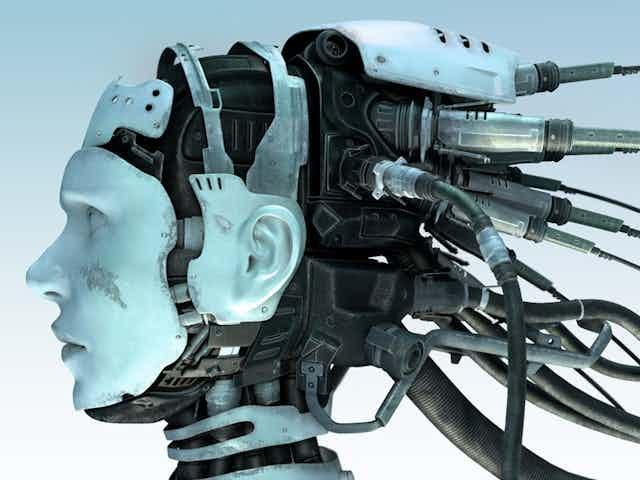“And, for an instant, she stared directly into those soft blue eyes and knew, with an instinctive mammalian certainty, that the exceedingly rich were no longer even remotely human.” William Gibson, Count Zero.
In May, a group of Japanese researchers announced that they had successfully synthesised the first artificial synapse – a development that could revolutionise machine intelligence and potentially help treat degenerative neurological conditions such as Alzheimer’s. But could the implications be even greater for humanity?
Synapses are integral to brain function – neurological switches that facilitate the transmission of electrical or chemical data between neurons, or between neurons and other cells; incredibly complex neurological structures comprised of the dynamic interactions of hundreds of proteins and other chemicals.
These interactions, due to plasticity of synaptic function can strengthen or weaken with time – facilitating, among other things, whether or not information is submitted to short or long-term memory – have a profound impact upon our capacity to learn and reason.
Unlike prior efforts, the synthetic synapse created by Japanese scientists operates in a fashion that mimics the behaviours of organic synapses, being similarly responsive to air pressure and temperature changes, opening up the possibility of an artificial brain that, like ours, can perceive the environment.

As mentioned, a development of this sort has certain very exciting potential applications. Among these may be the capacity to replicate neurological structures could revolutionise research into artificial neural networks.
With further research, it is clear that this technology could be used to replace failing biological synaptic systems. Should the potential inherent in these technologies be realised, within decades, diseases and disorders that cripple the minds of millions of people could be abolished with nanomedical treatments that are universally effective, non-invasive and (ideally) inexpensive.
Moreover, those treatments would likely prove to be minimally ethically contentious; despite effectively turning recipients into cyborgs, the therapeutic benefits are likely to painlessly override any of our deeply-held intuitions about the dehumanising effects of technology.
The threat of the post-human
But what if one were to freely volunteer to undergo such a procedure, despite not suffering from an evident neurological disorder? If the promise inherent in this technology can be kept, it will likely prove possible to consciously and actively augment our cognitive abilities in a material way.

Such an application is not terribly therapeutic – at least not by any intuitive conception of therapy - but it does have some kind of positive utility. Does the mere fact of observing this utility override our intuitions? Should our hypothetical volunteer be allowed to receive the surgery?
Unfortunately, there appears to be a broad assumption – in public debate, policy and popular journalism – that human augmentation technologies are, on the whole, considered to be within the purview of science fiction: radical life extension, intelligent robot helpers, gene therapy, mind uploading, molecular assemblers.

There’s an implicit judgement at play: being the traditional purview of philosophy and genre fiction, the sociological and ontological ramifications of these technologies are not considered worthy objects of public attention. As a result, public figures in Australia remain deafeningly silent, even despite several half-hearted attempts to invigorate the issue.
The relevance of these concerns
This approach would be appropriate were these concepts merely an exercise in philosophical navel-gazing. But many of those technologies listed above are either in active development, or are already (in a primitive sense) part of our medical or technological repertoire.
Techniques such as those isolated by the Japanese researchers could serve to actively facilitate the enhancement of human cognitive abilities in addition to being a meaningful step towards capacity-boosting neurological implants.
The following points are also worth noting:
- Gene therapy, despite being considered a techno-fantasy by many, has been a viable medical procedure since the successful treatment of Ashanti DeSilva for an immunological disorder way back in 1990;
- Honda’s disarmingly adorable robot ASIMO is capable of rendering untrained perceptual judgements about the world around it;
- nootropics or “smart drugs” such as modafinil and piracetam promise to meaningfully aid cognitive capacities with minimal side effects, while enzymes such as resveratrol show promise in extending the lifespan of vertebrates;
- We already live in a world grappling with the ramifications of radical life extension, and human longevity is only set to increase.
The potential effects of these technologies cannot be understated: in addition to the social and economic problems posed by augmentation technologies, they may well serve to challenge our collectively held intuitions about what it means to be human (whatever they may be).

Already, technological development outpaces legislative and legal responses, and will only continue to accelerate. Given law is primarily reactive discipline, lawmakers are inevitably playing catch-up; as the ongoing imbroglio regarding IP law and the internet demonstrates, the legal system can take years, if not decades, to account for new technologies.
Given what’s potentially at stake, it’s not enough to rely on the glacial reactions of politicians and judges.
Even if no conclusions are drawn, it behooves us to begin this conversation now.

